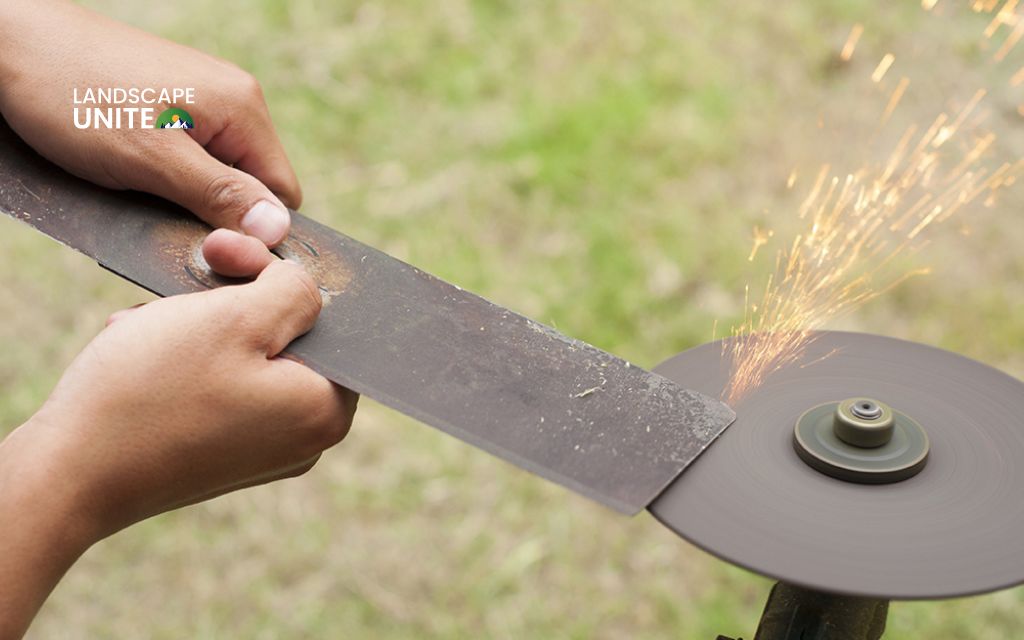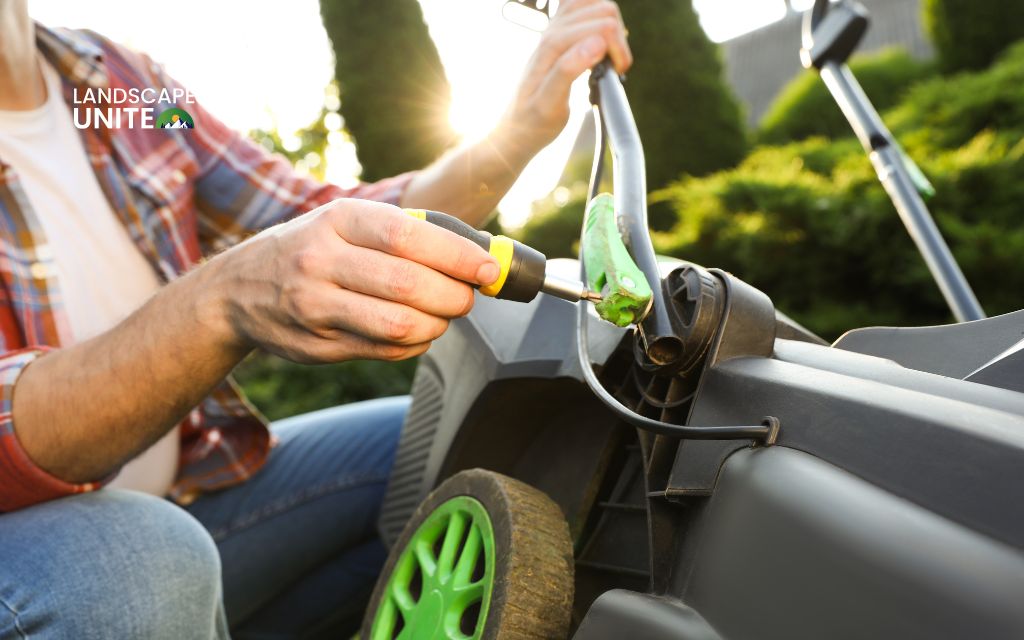How do you make a lawn mower go faster? Want to cut your mowing time in half? Whether you’re maintaining a large property or dealing with thick grass, there are proven ways to safely increase your lawn mower’s speed.
These 6 methods will help you finish faster while maintaining quality cuts. These methods have been tested by professionals and DIY enthusiasts, ensuring you get real-world results that make a difference in your mowing routine.
Let’s dive into the specific techniques in the article below!

How do you make a lawn mower go faster?
1. Keep the mower well-maintained
- Clean or replace the air filter: Check every 25 hours of use or monthly during peak season. Clean foam filters with warm soapy water and re-oil, or replace paper filters when they appear gray or clogged. A clean filter improves performance by up to 10% and increases fuel efficiency.
- Change oil on schedule: Replace oil every 50 hours or annually, whichever comes first. Use SAE 30 for temperatures above 40°F, or 10W-30 for variable climates. Consider synthetic oil for better protection and slightly improved performance. Fresh oil reduces internal friction by up to 15%.
- Inspect and clean spark plugs: Replace spark plugs annually or every 100 hours of operation. Clean carbon buildup with a wire brush and check gap spacing (typically 0.030 inches). A functioning spark plug ensures complete fuel burn and maximum power output.
2. Sharpen blades & adjust cutting height
- Sharp blades reduce drag and make cleaner cuts: Dull blades can reduce efficiency by 25%. Sharpen every 20-25 hours of use or 2-3 times per season. Professional sharpening costs $10-15, or DIY with a bench grinder maintaining the original 30-45 degree angle.
- Lower cutting height (within safe limits): Follow the 1/3 rule – never cut more than one-third of grass blade length. Maintain 2.5-3 inches for cool-season grasses (fescue, bluegrass), 1.5-2.5 inches for warm-season varieties (Bermuda, Zoysia). Lower cuts reduce grass volume processed by 20-30%.
- Balance your blades after sharpening: Unbalanced blades create vibration that slows the mower and damages the engine. Test balance by hanging the blade on a nail through the center hole.

3. Upgrade fuel & air intake
- Use higher-octane fuel: Premium fuel (91+ octane) can increase power by 3-7% in high-compression engines. Add fuel stabilizer like STA-BIL for storage over 30 days. Ethanol-free gas provides better performance and longer storage life.
- Upgrade to a high-flow air filter: Performance filters like K&N or AEM increase airflow by 10-20% while maintaining filtration. Cost $25-50 but are washable and reusable for 5+ years. Combine with cold air intake for additional 2-3% power gain.
- Clean or upgrade the carburetor: Remove fuel residue and adjust mixture screws for optimal fuel-air ratio. Consider carburetor rebuild kits ($15-30) for older mowers or performance carburetors for significant upgrades.
4. Adjust the governor or change pulleys
- Shorten or replace the governor spring (for controlled RPM increase): Carefully adjust to increase maximum RPM by 200-500. Use a tachometer to monitor changes – never exceed the manufacturer’s red line. Start with small 1/4 turn adjustments on the spring screw.
- Install a larger pulley on belt-driven models: Increase drive pulley diameter by 10-25% for proportional speed gains. A 4-inch to 5-inch upgrade provides 25% more speed. Ensure proper belt alignment and check for interference.
- Modify variable speed controls. On self-propelled mowers, adjust the speed control cable or linkage to allow higher maximum speeds.
5. Make basic hardware upgrades
- Use larger or low-resistance tires: Upgrade from 8-inch to 10-inch rear tires for 25% speed increase. Choose pneumatic over solid tires for better rolling resistance. High-tread tires improve traction on slopes but create more drag.
- Upgrade the engine or carburetor: Install a larger carburetor (increase size by 10-20%) or swap to a higher horsepower engine. Popular upgrades include Predator 212cc or Honda GX200 engines. Professional installation recommended for major swaps.
- Adjust transmission ratios (especially for hydrostatic mowers): Locate the speed adjustment screw on hydrostatic transmissions – usually near the pump. Small adjustments can increase top speed by 15-30%. Some riding mowers have speed limiting plates that can be modified.
- Install performance exhaust systems: High-flow exhaust systems can add 2-5% more power and improve engine sound. Ensure compliance with local noise ordinances.

6. Reduce weight & optimize mowing patterns
- Remove unnecessary attachments: Remove baggers when mulching (saves 10-15 lbs), take off striping kits when not needed (5-10 lbs), and eliminate tool holders or cup holders. Every 10 pounds removed can improve acceleration and hill climbing.
- Plan mowing routes: Use GPS apps like iMow or LawnMap to optimize patterns. Mow perimeter first, then use parallel strips with 10% overlap maximum. Efficient patterns reduce total mowing time by 20-40%.
- Mow when conditions are optimal: Cut grass when dry and avoid mowing during peak heat. Morning mowing (after dew evaporates) or early evening provides best conditions for speed and cut quality.
Why increase your lawn mower’s speed?
- Save time: A 25% speed increase reduces a 4-hour mowing job to 3 hours. For properties over 2 acres, time savings become significant – potentially saving 3-5 hours per week during the growing season.
- Improve mowing efficiency: Higher blade tip speeds (ideal range: 15,000-18,000 FPM) create cleaner cuts that heal faster and look better. Consistent ground speed maintains uniform overlap patterns.
- Ideal for homeowners who have busy schedules or multiple acres to maintain: Professional landscapers can increase productivity by 30-50% with properly modified equipment. Commercial operators often see ROI within one season.
- Better fuel efficiency at optimal speeds: Engines operating at peak efficiency RPM often use less fuel per acre covered, despite higher speeds.
Safety warnings before you modify
Modifications can void warranties and increase accident risks
Most manufacturers void warranties for any speed or power modifications. Document baseline performance before modifications. Higher speeds increase stopping distances by 40-60% and reduce reaction time.
Always wear protective gear
Protective gear include safety glasses, gloves, sturdy footwear, and (if needed) a helmet. At higher speeds, debris becomes more dangerous – small stones can become projectiles at 200+ mph blade tip speeds. Steel-toed boots and long pants provide additional protection.
Test modifications in a wide, open space before regular use
The test area should be at least 100 x 100 feet, free of obstacles. Gradually increase speed while testing steering response, braking, and stability. Practice emergency stops and turning maneuvers.
Never fully remove the speed limiter
Never fully remove the speed limiter, use safe adjustment methods instead. Complete governor removal can cause catastrophic engine failure at 6000+ RPM. Engine components can become projectiles, causing serious injury or death.

Conclusion
Speeding up your lawn mower can save significant time and make mowing more efficient, especially for large properties.
Start with basic maintenance – often the most cost-effective improvements. Progress to simple modifications like blade sharpening and air filter upgrades before attempting mechanical changes.
The key is balancing performance gains with safety and reliability. A well-maintained mower with a few strategic upgrades will outperform a neglected machine with expensive modifications. Most homeowners see 20-40% time savings with these methods while maintaining cut quality and equipment longevity.
Find more detailed lawn mower strategies and garden equipment advice in our comprehensive gardening guide collection.
Frequently asked questions (FAQs)
Will adjusting the governor damage my mower?
Small, controlled adjustments (200-300 RPM increase) are generally safe, but excessive changes can cause premature wear, overheating, and void warranties. Always use a tachometer to monitor RPM changes.
Does a high-performance air filter really make a difference?
Yes, quality aftermarket filters can improve airflow by 10-20%, resulting in 3-7% power increase. The improvement is most noticeable during sustained high-load operation and becomes more apparent when combined with other modifications.
Can I remove the speed limiter?
Absolutely not recommended – it’s designed to prevent dangerous over-speed conditions that can cause loss of control, engine failure, and serious injury. Use safer methods like pulley changes and governor adjustments instead.
Will higher speeds overheat my mower?
Higher speeds increase engine load and heat generation. Ensure cooling fins are clean, air intake screens are clear, and take breaks during extended operation. Consider upgrading cooling systems for significant power increases.
What’s the most cost-effective modification for speed?
Regular maintenance (clean air filter, sharp blades, fresh oil) provides the best speed improvement per dollar spent. These basics often yield 15-25% performance gains for under $50 total cost.
How much faster can I safely make my mower?
Most mowers can safely achieve 20-40% speed increases through proper modifications. Ground speeds of 4-6 mph are realistic for walk-behind mowers, 6-10 mph for riding mowers, without major safety concerns.


